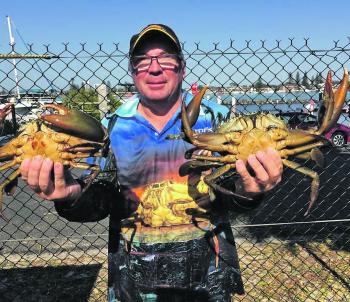Not having enough time to do all the different types of fishing that’s available throughout February is a great problem to have – it’s also one I try to address each year with little success.
Offshore you have mahimahi hugging the DPI FAD, marlin travelling along the current slicks and pearl perch, snapper and flatties waiting on the shallow reefs. If you’re lucky, you’ll stumble across a pack or two of big kingfish that hunt the bonito and slimy mackerel schools. For a seafood dinner closer to home and with a little more variety, you could hit the lake and tributaries for the prawns, crabs and fish that are there for the taking. Prawning from around 26 February to 2 March will deliver plenty of good-sized channel prawns. You’ll have to be keen though, with the run-out tide and the adjustment for the lake delay keeping you out into the early morning. The bright side to the prawning hours is while you’re up you may as well go fishing and crabbing.
The tributaries are in full swing, with bream actively chasing prawns along the banks and often out in the middle of the rivers. Early mornings are the best time to target the bream on surface, before the sunlight and heat hit the water. Sugapens, 3B Pop Dogs and Tiemco Soft Shell Cicadas are must-have surface lures, but be warned, the Soft Shells can suffer horrendous damage in the mouth of a big bream.
The timber and rock snags that line the rivers are great spots to practice your hardbody techniques, particularly as the sun rises higher in the sky. Running lures along the length of any timber laydowns is a good way to draw the fish from cover during the run-out tide. The run-out tide helps to draw the fish off the bank and away from the undercut areas where they hide and feed during high water. While you’re up any of the four rivers that make up the estuary, it pays to set a crab pot or two along the deeper mangrove edges, and with any luck, you’ll pick up a mud crab or two. The crabbing has been pretty good so far this season, with plenty pulled out of the Coolongolook and Wallamba rivers.
The blue swimmer population of the lake has had a bit of a hammering over the school holidays, but there are still enough getting around to make setting worthwhile. Please observe crabbing regulations, don’t touch other people’s gear, and remember there are only two pots per person. One visitor got caught with four pots in his possession (by himself) and 18 blue swimmers – leaving him with a fine of $1200. That level of infringement is more than justified, considering the wilful disregard for the law. For the best and easiest results with the blue swimmers, set your pots on the edge of weed beds that have a drop-off into deeper water. Areas like The Step and in the lake itself near Coomba Park and Booti Island or the back of Yahoo Island will all produce crabs.
For those anglers who just want to go out and get a feed of whiting or flathead, you don’t have to go too far past the Paddock or the edge of Godwin Island, leading up to Hells Gate. There are also some big tailor patrolling this area and bream mooching around with the run-in tide, so be prepared for anything. The channel on the western side of Little Tern Island has been producing good legal flathead with the chance of a trophy fish. While fishing the washboards recently for bream, I scared off four 90cm+ flathead close to the leases and weed beds. There are plenty of poddy mullet in the 50-80mm size range getting around the shallows, and a live mullet on a hook is the best guarantee of a big flathead.
If you do get a few mullet for bait you could wander down to the Tuncurry breakwall and feed the mulloway. Alternatively, you can use soft plastics on a 1oz jighead for one of the legal school-size fish that hang around the end of the structure.
Due to the volume of water that pours from the lake during the run-out, it’s best to fish the slack water at the bottom of the tide. If you get to the wall too early and the tide has some run left in it, try the Tuncurry Beach side at the end of the wall. Mulloway will often hang in the water that spills back onto the beach during the heavy run-out tide. As the run-out tide slackens, the mulloway move from the beach end onto the channel side.
Bass fishing in the area is suffering from hot weather, not much water flow and plenty of weed growth choking many popular spots. Hot water makes the fish lethargic through the day, and the best option is to get on the water in the late afternoon and evening for a surface session. Here’s hoping for good rainfall by the time you read this.
Reads: 1936
Chris Reggers landed this 75cm mulloway from the breakwall. This beauty is typical of the quality around at present.

Stephen Hawkins loves the summer muddies, and this year has already produced some crackers.

Wallis Lake is renowned for big bream. This 850g fish came from the edge of Godwin Island.




